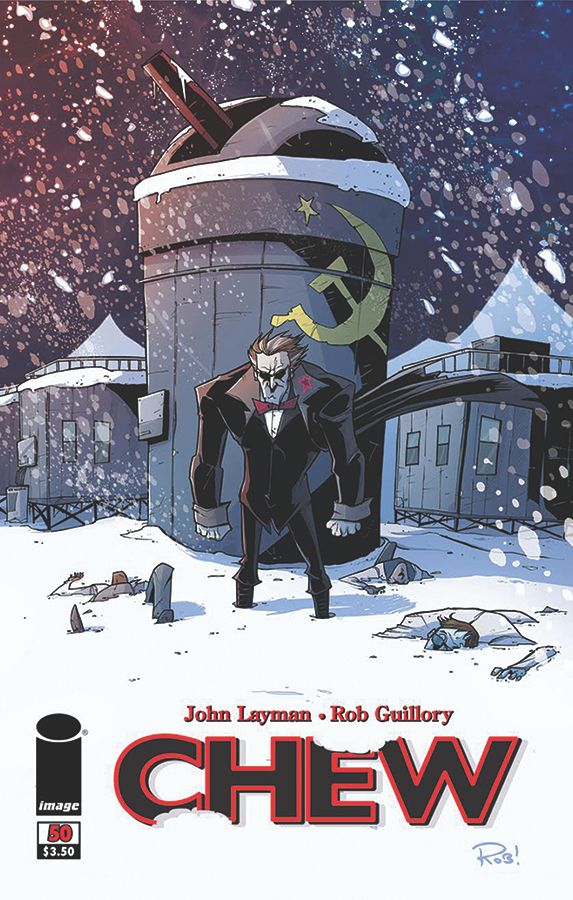"Chew" #50 by John Layman and Rob Guillory is not only a landmark issue and the end of the "Blood Puddin'" story arc, but also the stage for the epic battle that has been building for over forty issues, ever since the first appearance of Tony Chu's arch-nemesis, the Collector -- a.k.a. the Vampire in "Chew" #7.
Guillory's combat scenes have a wilder energy to them than ever before, emphasizing the power of the combatants. His color palette for the fight scenes is also pared down to black, white, gray and blood red, giving the action starker focus. Layman raises doubt about who will triumph by showing Tony and the Collector's respective pre-battle preparation. The Collector squeezes in several last-minute power acquisitions, while Tony depends solely on the meal his brother Chow prepared last issue.
Mid-fight, Layman inserts two flashbacks. They remind the reader of Tony's path towards this battle and also reinforce the dual nature of the fight and how it both a solo mission and a team effort. Layman used Toni's knowledge to make it logical and right that Tony should face the Collector alone and, although that was a little too convenient, it was all for this scene, so that the final showdown would be one-on-one.
The flashbacks also contain what screenwriting theorists call a pinch point, or a reminder of who the antagonist is and what is at stake. Olive's gift to her dad is structurally convenient, providing Tony with a weapon, but it is also symbolic of all that Tony has lost and all that he still stands to lose should he fail. The dialogue during the fight is similarly formulaic but does the job.
Guillory's transitions and panel compositions assist in breathlessly fast pacing and a stunning two-page climax. However, within the larger arc, the combat's conclusion is oddly anticlimactic. The final fight is extremely short compared to the years-long long buildup to this scene. It's a smart move for Layman to immediately segue into another kind of struggle afterwards, in which there are two classic temptations: power and knowledge. This Faustian scene has emotional and moral depth, and it's just as exciting as the physical tussling, if not more so, especially with the hints about space fruit and fire writing. It's also fascinating to see the Collector in his first real moment of vulnerability, as the reader learns what he truly values even above all else. However, the scene also feels cut short, because Tony's decision is so swift. Characterization wins over dramatic potential, but it's hard to lament the preservation of Tony's heroism. While there are small surprises along the way, the takeaway impression of the Chu vs. Collector fight is that it is satisfies all the requirements but is ultimately predictable.
The humor in "Chew" #50 takes a back seat for obvious reasons, but the new food power profiles, background gags and the fake epilogue are the same great flavor as always. The real surprise is the full-page epilogue. Layman has a fiendish sense of timing, catching the reader off-guard while the battle is still fresh. I love plot twists, but they must be earned. This particular twist is likely to upset or disappoint some readers. To torture a male hero this way for emotional effect is a cliche old enough to have its own name. There have been losses of similar magnitude already, but Layman managed to carry those off. Part of me hopes that Layman is bluffing but, if not, he's setting up reader expectations and a challenge for himself over the next arc.
"Chew" #50 is an exciting, fast meal, comprised of less filling fare than what Layman and Guillory usually cook up. There's not much to digest afterwards, except for the shock of the epilogue. This isn't their very finest work on "Chew," but it does justice to Tony's strength as well as the Collector's might. There are only ten more issues to go, and the events of "Chew" #50 leave the door wide open to explore wackier settings and ideas, like Toni Chu's current whereabouts and what she foresaw.

